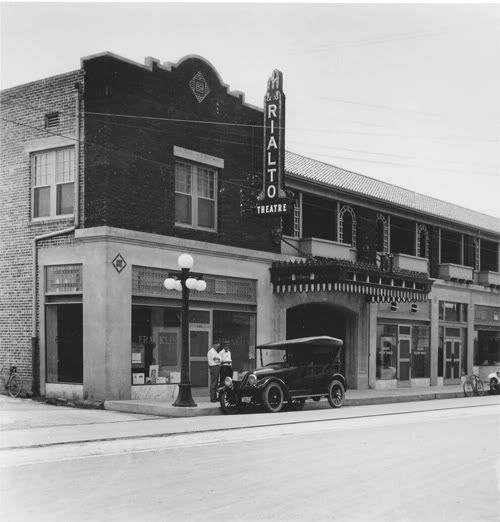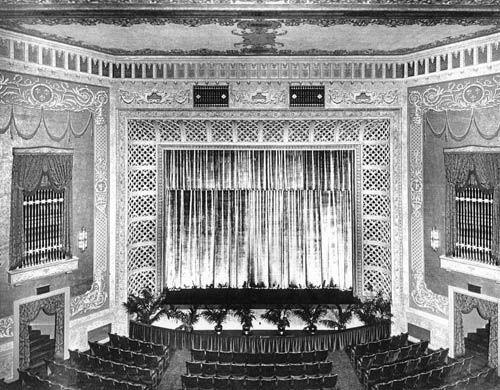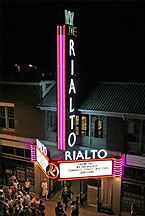An update on a few downtown historic preservation projects:
Rialto Facelift Set to Begin
Downtown Tucsonan
September, 2006
Rialto Theatre, circa 1925

Rialto Theatre - original stage

new marquee - 2005

(for more info.:
http://www.rialtotheatre.com/)
First, the theater interior was renovated. Then, the neon marquee was installed. This summer, air-conditioned cool air filled the theater. The next move in the redevelopment of the 300 block of East Congress, aka the Rialto Block, is finally beginning in September with renovation of the historic Rialto Building’s entire façade. The project is expected to take about five months to complete.
“After nearly four years of excruciating delay, I’m thrilled we can finally do what I promised to do back in 2002,” said Doug Biggers. He and his partner, architect Tom Powers, are the force behind Rialto Redux, LLC, a small development company with a passionate commitment to historic preservation and the revitalization of Downtown. Rialto Redux owns the entire block except for the Rialto Theatre, which is owned by the Rio Nuevo District.
The renovation of the building’s façade will follow the Secretary of the Interior’s Standards, which means it complies with best practices for the restoration and renovation of historic buildings. The façade renovation is the first phase in a complete rehabilitation of the Rialto Building, which was one of Tucson’s first mixed-use projects when it was built in 1920.
The second floor will have 14 unique market-rate apartments for rent, and will also house the Rialto Theatre’s administrative offices. The ground floor will be anchored by a restaurant/bar, which will feature a private courtyard in the back of the building. Biggers said they are very close to announcing a deal with a restaurateur. Other ground-floor uses under discussion are an indie record store, a small market and office lofts on the Fifth Avenue frontage. The Rialto Theatre will expand its box office and concession area into two storefronts on the east end of the building.
“We wanted to start with the façade first, since it has the greatest impact visually. The rest of the project is being sequenced during and after the façade work, with completion of the entire rehabilitation scheduled for August 2007,” said Biggers. Planning and design work is still ongoing for the south side of the block. “In the end, we want to make the south side of the building as architecturally memorable as the Congress and Fifth Avenue façades,” Biggers said. “The renovated façade will dramatically improve the entire block, but I’m especially pleased about its positive impact on the theatre and its operations,” said Biggers. “It’s amazing that so many of the theatre’s patrons have been willing to tolerate the block in its current abysmal condition. I believe that investment in the façade can help us to continue to build audience for the theatre’s programming.”
As executive director of the nonprofit foundation that leases the Rialto Theatre from the City, Biggers oversaw a $600,000 renovation of the theatre in 2005, including the installation of a new marquee in June 2005. Re-opened in April 2005 after being closed for almost a year, the Rialto Theatre has hosted more than 130 concert events, with nearly 80,000 patrons passing through its doors. The redevelopment of the Rialto Block was made possible by a partnership between the City, an independent nonprofit foundation, and the private sector, all of which are working together to leverage public and private dollars to catalyze the revitalization of East Congress Street.
Biggers is concerned that public investment be made as strategically as possible on the east end of Downtown. “It’s important that we get the details right on the final design for the Fourth Avenue underpass and move swiftly to a construction start date within a year.” “I can’t emphasize how important it is to make other key decisions so the modern streetcar project is not delayed,” Biggers said. “Having been to Portland and seen the evidence of what happened in the Pearl District, the community needs to understand that the streetcar will have a profound economic development impact on the entire corridor. It’s a key component to making the larger Downtown area finally hit critical mass.”
DETAILS OF THE RIALTO FAÇADE PROJECT
* Significant repair of masonry elements and complete plaster repair and repainting of the entire building.
* Replication of the prismatic, leaded-glass transoms above the storefronts along Congress and Fifth Avenue, at a cost of nearly $75,000.
* Virtually the entire ground-floor façade is being demolished to remove modern aluminum window frames and doors installed in the mid-1980s. In their place will be marble bases for the storefront windows, wood doors, and replication of the original window frames. What little original material that remains will be restored.
* The dilapidated wood windows are being replaced with high quality, historically accurate replicas.
* Rehab of all second floor balcony elements.
* The façade project will cost approximately $400,000, with $150,000 coming from a Back to Basics grant from Mayor Walkup and the Ward 6 office.
THE FUTURE MEETS THE PAST
Downtown Tucsonan
September, 2006
90-year old Marist College building
 It’s a bit of an ironic puzzle that while millions of dollars in Rio Nuevo monies will be spent on Tucson Origins to re-create historical buildings that no longer exist, some still-standing historical buildings continue to deteriorate due to neglect or lack of funding. One of these still-standing-but-not-for-long historic structures is the 90-year-old Marist College building at West Ochoa Street and South Church Avenue. Local architects say the three-story adobe building, used as a Catholic school from 1915-1968, is unique --- the last of its kind --- the only three-story adobe building still standing in Southern Arizona.
It’s a bit of an ironic puzzle that while millions of dollars in Rio Nuevo monies will be spent on Tucson Origins to re-create historical buildings that no longer exist, some still-standing historical buildings continue to deteriorate due to neglect or lack of funding. One of these still-standing-but-not-for-long historic structures is the 90-year-old Marist College building at West Ochoa Street and South Church Avenue. Local architects say the three-story adobe building, used as a Catholic school from 1915-1968, is unique --- the last of its kind --- the only three-story adobe building still standing in Southern Arizona.
The need to address this situation, and the irony that the Mission San Agustin complex and El Presidio de Tucson are being rebuilt through Rio Nuevo’s Tucson Origins, are not lost on Downtown business owner Jeff DiGregorio. “I hope that we’re not setting ourselves up for another Tucson Origins project in the future, where we have to spend a lot of money to re-create something that we could have saved today,” says DiGregorio, who, along with partner Chuck Bressi, owns and operates the Royal Elizabeth Bed and Breakfast Inn on South Scott Avenue, just a block away from the Marist Building. “Building Tucson Origins is absolutely the right thing to do, but let’s not forget about what is crumbling before our eyes.”
The structure suffered a major blow last year when parts of the northwest corner of the building fell off during the monsoon season. Additional rain this monsoon season has brought more deterioration to the building, vacant since 2002.
The Roman Catholic Diocese of Tucson estimates a $2-to-$3 million cost to refurbish the place and the Friends of St. Augustine Historic Preservation Project have begun a fund-raiser. Ward One City Council Member Jose Ibarra has contributed $24,000 for a more exact cost study by the City Urban Planning Department. Ibarra has indicated the building would be designed for some kind of public use, should it be refurbished. The diocese has indicated interest in using the building as a museum to celebrate the history of Catholicism and other religions in Tucson. Repeated attempts to reach Council Member Ibarra to determine the status of the cost study proved unsuccessful.



